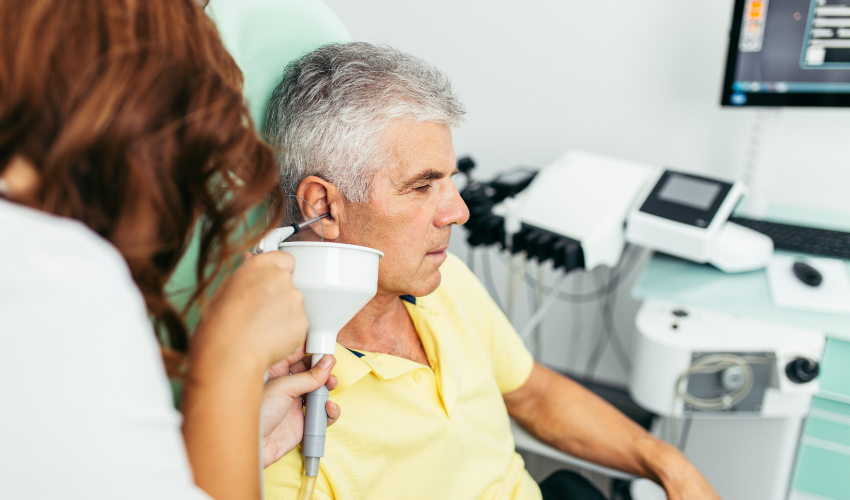Ear wax removal is a popular and effective treatment for those who struggle with blocked ears due to a build-up of ear wax. Professional ear wax removal can drastically improve your hearing when performed correctly.
However, some people aren’t aware of the different methods used to remove ear wax. So, in today’s article, we will be diving into the different methods of ear wax removal, and discuss which method you shouldn’t use to remove wax.
Ear syringing
The first method on our list is ear syringing. Ear syringing has historically been used to remove ear wax due to its ‘flushing’ technique. It involves using a syringe to introduce a stream of warm water into the ear canal, to dislodge and flush out accumulated ear wax. While this method has been used for many years, there are growing concerns among audiologists about its safety.
Procedure
The procedure begins with the injection of warm water into the ear canal. The temperature is always carefully regulated to ensure comfort and to help soften the ear wax. The water will intend to dislodge the wax by breaking it up. Once complete, the water, along with the dislodged ear wax, is allowed to drain out of the ear, usually aided by the natural angle of the ear.
Risks & concerns
This procedure has worked in the past, but there are concerns and risks you should know about. Firstly, there is a risk of injury with ear syringing, as if the force of water isn’t controlled correctly it can lead to trauma to the delicate structures of the ear, including the eardrum. Also, the effectiveness of ear syringing can vary from person to person. In some cases, it may successfully remove ear wax, while in others, it may push the wax deeper into the ear canal. Finally, there is an infection risk too, as the water in the ear creates a moist area if not properly sterilised.

Ear Irrigation
The next ear wax removal method on our list is ear irrigation. Ear irrigation involves the controlled introduction of warm water into the ear canal. This procedure is often supervised by audiologists to ensure its safety and effectiveness. Ear irrigation is considered a gentler alternative to ear syringing, with a focus on minimising the risk of injury while effectively removing excess ear wax.
Procedure
It begins with warm water carefully poured into the ear canal. The temperature is regulated to ensure patient comfort and to aid in softening the ear wax. Unlike ear syringing, ear irrigation typically involves a controlled flow of water, minimising the risk of trauma to the delicate structures of the ear. The warm water will soften the wax, making it easier for it to flush out of the ear.
Risks & concerns
Like ear syringing, there is a potential risk of infection if the water used in the irrigation process is not properly sterilised. Also, ear syringing can vary from person to person, as it may not be suitable for individuals with certain ear conditions or abnormalities.

Microsuction
Possibly the safest method of removing ear wax, microsuction is next on our list. This technique utilises a specialised suction device, often equipped with a microscope for enhanced visibility, to gently remove excess ear wax from the ear canal. It’s become the gold standard for safely removing ear wax across the globe due to its precision. You can target specific areas and remove ear wax without affecting the surrounding healthy tissue.
In addition, because it is performed under direct visualisation, microsuction minimises the risk of injury to the delicate structures of the ear, such as the eardrum. This in turn makes the individual have minimal discomfort throughout the procedure.
Procedure
Before the procedure begins, the audiologist will examine the ear using a microscope. This allows for a detailed view of the ear canal and identification of any obstructions or issues. Then, a small, gentle suction device is then used to carefully remove the ear wax. The audiologist will have full control of the device ensuring that only the targeted wax is removed without causing harm to the ear canal or eardrum.
Risks & concerns
The only concern with microscution is that because it requires specialised equipment, not every hearing specialist facility may have the tools for it. However, it is becoming more common for audiologists to possess them.
Here at Sutton Hearing Centre, our team is at hand to provide expert and helpful advice; whether you have had microsuction before or this is your first time, our audiologists will be happy to guide and assist you throughout the treatment.
Do not use cotton buds
Now we’ve discussed the different types of ear wax removal methods, we must discuss what you shouldn’t use to remove wax from your ears.
We can’t stress enough why you shouldn’t use cotton buds to remove ear wax. There are multiple risks with this method. Firstly, because you’re pushing the ear wax in, it will travel deeper within the ear canal, which will create a blockage and impact the eardrum. Also, using a cotton bud can increase the risk of an injury too, as they can potentially damage the sensitive skin lining the ear canal and eardrum. Furthermore, using cotton buds doesn’t clean the ears, it only pushes wax around the ears rather than removing it. It provides a false sense of cleanliness and exacerbates the underlying issue.
Many audiologists including ourselves strongly advise against using this tool for ear wax removal. The delicate nature of the ear canal and the potential for unintentional harm, make at-home ear cleaning with cotton buds risky.
If you’re struggling with blocked ears, avoiding at-home methods and finding a reputable, certified audiologist to perform ear wax removal is the safest and most effective solution.
We hope you’ve enjoyed reading our latest article about the different methods of ear wax removal. If you have any questions or would like to book an ear wax removal appointment – get in touch with our team today.

